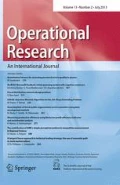Abstract
The long-term viability of a business organization depends on its ability to evaluate the performance of the employees and to examine the contribution of its personnel in achieving the assessed goals. In this context, the evaluation of employees may provide a quantitative measure of their appraisal aiming at determining the degree of conformance between the job output and the defined standards. The main aim of this study is to present the development of an employee evaluation system in a healthcare organization. The proposed approach is based on multicriteria analysis and considers the complexity of the different job profiles. In particular, the applied quantitative model constitutes a variant of the UTA method, taking into account the strategy of the organization and the preferences of the management. The main advantage of this approach focuses on its ability to use absolute performance measures and to develop an evaluation system that can handle qualitative (ordinal) information. Moreover, using the proposed approach, employees are evaluated on a set of different but specific job dimensions, providing the ability to perform different types of comparison analyses.





Similar content being viewed by others
References
Afshari AR, Mojahed M, Yusuff RM, Hong TS, Ismail MY (2010) Personnel selection using ELECTRE. J Appl Sci 10(23):3068–3075
Becker BE, Gerhart B (1996) The impact of human resource management on organizational performance: progress and prospects. Acad Manage J 39(4):779–801
Cheng EWL, Li H (2006) Job performance evaluation for construction companies: an analytic network process approach. J Const Eng Manage 132(8):827–835
DeCenzo DA, Robbins SP (2005) Fundamentals of human resource management, 8th edn. Wiley, New Jersey
Gliddon DG (2010) Performance management systems. In: Watkins R, Leigh D (eds) Handbook of improving performance in the workplace: selecting and implementing performance interventions (vol. 2). Pfeiffer, San Francisco, pp 299–317
Guest DE, Michie J, Conway N, Sheehan M (2003) Human recourse management and corporate performance in the UK. British J Ind Relat 41(2):291–314
Jacquet-Lagrèze E, Siskos Y (1982) Assessing a set of additive utility functions for multicriteria decision making: the UTA method. Eur J Oper Res 10(2):151–164
Jacquet-Lagrèze E, Siskos Y (2001) Preference disaggregation: 20 years of MCDA experience. Eur J Oper Res 130(2):233–245
Mathis RL, Jackson JH (2007) Human resource management, 12th edn. South-Western College Pub, Cincinnati
Oral M, Kettani O (1989) Modelling the process of multiattribute choice. J Operat Res Soc 40(3):281–291
Ostroff C, Bowen DE (2000) Moving HR to a higher level: HR practices and organizational effectiveness. In: Klein KJ, Kozlowski SWJ (eds) Multilevel theory, research, and methods in organizations: foundations, extensions, and new directions. Jossey-Bass, San Francisco, pp 211–266
Polychroniou PV, Giannikos I (2009) A fuzzy multicriteria decision-making methodology for selection of human resources in a Greek private bank. Career Dev Int 14(4):372–387
Saaty TL (2005) The analytic hierarchy and analytic network processes for the measurement of intangible criteria and for decision-making. In: Figueira J, Greco S, Ehrgott M (eds) Multiple criteria analysis: state of the art surveys. Springer, New York, pp 345–407
Sels L, De Winne S, Delmotte J, Maes J, Faems D, Forrier A (2006) Linking HRM and small business performance: an examination of the impact of HRM intensity on the productivity and financial performance of small businesses. Small Bus Econ 26(1):83–101
Siddiqui J, Kleiner BH (1998) Human resource management in the health care industry. Health Manpower Manage 24(4):143–147
Siskos Y, Grigoroudis E (2010) New trends in aggregation-disaggregation approaches. In: Zopounidis C, Pardalos PM (eds) Handbook of multicriteria analysis. Springer, Heidelberg, pp 189–214
Siskos Y, Yannacopoulos D (1985) UTASTAR: an ordinal regression method for building additive value functions. Investigação Operacional 5(1):39–53
Siskos J, Spyridakos A, Yannacopoulos D (1993) MINORA: a multicriteria decision aiding system for discrete alternatives. J Inform Sci Technol 2(2):136–149
Siskos Y, Spiridakos A, Yannacopoulos D (1999) Using artificial intelligence and visual techniques into preference disaggregation analysis: the MIIDAS system. Eur J Oper Res 113(2):236–246
Siskos Y, Grigoroudis E, Matsatsinis NF (2005) UTA methods. In: Figueira J, Greco S, Ehrgott M (eds) Multiple criteria analysis: state of the art surveys. Springer, New York, pp 297–344
Spyridakos A, Siskos Y, Yannakopoulos D, Skouris A (2000) Multicriteria job evaluation for large organisations. Eur J Oper Res 130(2):375–387
Tabachnick BG, Fidell LS (1989) Using multivariate statistics. Harper/Collins, New York
Taylor FA, Ketcham AF, Hoffman D (1998) Personnel evaluation with AHP. Manage Decis 36(10):679–685
Torrington D, Hall L, Taylor S (2008) Human resource management, 7th edn. Prentice Hall, Harlow
Author information
Authors and Affiliations
Corresponding author
Appendix: Marginal value functions (managers of all departments)
Appendix: Marginal value functions (managers of all departments)
See Fig. 6.
Rights and permissions
About this article
Cite this article
Grigoroudis, E., Zopounidis, C. Developing an employee evaluation management system: the case of a healthcare organization. Oper Res Int J 12, 83–106 (2012). https://doi.org/10.1007/s12351-011-0103-9
Received:
Revised:
Accepted:
Published:
Issue Date:
DOI: https://doi.org/10.1007/s12351-011-0103-9





